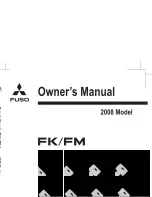
PRECAUTIONS FOR OPERATION
PRECAUTIONS FOR JOBSITE
INVESTIGATE AND CONFIRM JOBSITE CONDITIONS
On the jobsite, there are various hidden dangers that may lead to serious personal injury or death. Before start-
ing operations, always check the following to confirm that there is no danger on the jobsite.
• Check the terrain and condition of the ground at the jobsite, and determine the safest method of operation.
Do not operate in a dangerous area where landslides or rockfall may occur.
• Take necessary measures to prohibit the unauthorized person from coming close to the machine during op-
eration.
• When traveling or operating in shallow water or on soft ground, check the water depth, speed of the current,
condition of bedrock, and shape of the ground beforehand. Always avoid any place that will obstruct travel.
• Maintain the travel path on the jobsite so that there is no obstruction to travel operations.
PRECAUTIONS WHEN WORKING ON LOOSE GROUND
• Avoid driving or operating the machine near the edge of cliffs, road edges, and deep ditches. The ground
may be weak in such areas. If the ground should collapse under the weight or vibration of the machine,
there is a hazard that the machine may fall or tip over. Remember that the soil is weak in these areas, after
heavy rain or blasting or after earthquakes.
• When working on embankments or near excavated ditches, there is a hazard that the weight and vibration
of the machine will cause the soil to collapse. Before starting operations, take steps to ensure that the
ground is safe and to prevent the machine from rolling over or falling.
DO NOT GO CLOSE TO HIGH-VOLTAGE CABLES
Do not drive or operate the machine near electric cables. There is a hazard of electric shock, which may cause
serious personal injury or death. On jobsites where the machine may go close to electric cables, always observe
the following.
• Before starting work near electric cables, inform the local
power company of the work to be performed, and ask
them to take the necessary action.
• Even going close to high-voltage cables can cause electric
shock. Always maintain a safe distance (see the table) be-
tween the machine and the electric cable. Check with the
local power company about the voltage of cables and safe
operating procedure before starting operations.
Voltage of Cables
Safety Distance
100 V, 200 V
Min. 2 m
6600 V
Min. 2 m
22000 V
Min. 3 m
66000 V
Min. 4 m
154000 V
Min. 5 m
187000 V
Min. 6 m
275000 V
Min. 7 m
500000 V
Min. 11 m
• To prepare for any possible emergencies, wear rubber shoes and gloves. Lay a rubber sheet on the opera-
tor's seat, and be careful not to touch the chassis with any exposed part of your body.
• Use a signalman to give warning if the machine approaches too close to the electric cables.
• When performing operations near high voltage cables, prohibit anyone other than related persons to come
close to the machine during operation.
PRECAUTIONS FOR OPERATION
SAFETY
2-20
Summary of Contents for HD325-8
Page 2: ......
Page 13: ...FOREWORD INTRODUCTION 1 11 ...
Page 25: ...LOCATION OF SAFETY LABELS SAFETY SAFETY LABELS 2 3 ...
Page 26: ...SAFETY LABELS SAFETY 2 4 ...
Page 340: ......
Page 424: ......
Page 425: ...SPECIFICATIONS 5 1 ...
Page 429: ...ATTACHMENTS AND OP TIONS Before reading this chapter read and understand the SAFETY 6 1 ...
Page 447: ...REPLACEMENT PARTS 7 1 ...
Page 463: ......










































